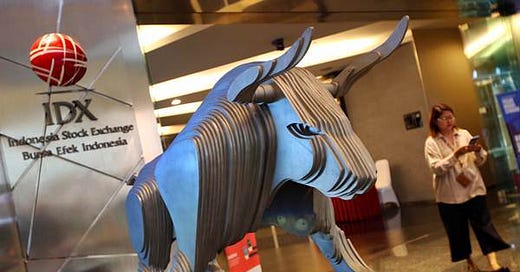The ASEAN Surge: Why Southeast Asia is Becoming the Next Investment Powerhouse
Recent Bloomberg reports all point to Southeast Asia becoming the new hotspot for global investors.
Dear partners and investors,
I’ve observed a striking trend in global investing. Recent Bloomberg reports — “Japanese, Mideast Firms Turn to Southeast Asia, BofA’s Siah Says,” “Global Money Piles Into Indonesia as Fed Easing Cycle Approaches,” and “Nomura Cuts Chinese Stocks to Fund Indonesia, Malaysia Switch” — all point to Southeast Asia becoming the new hotspot for global investors. Here’s a summary of the key points, insights, and implications from these reports.
Key Points
Middle Eastern and Japanese Investment in Southeast Asia:
Investment Shift: Companies from the Middle East and Japan are increasingly focusing on Southeast Asia as a prime destination for capital, moving some investment away from other parts of Asia.
Sector Focus: Key sectors include healthcare, digital infrastructure, renewable energy, and financial services.
Singapore’s Role: Singapore is emerging as a crucial hub for mergers and acquisitions (M&A), with its stable economic and political environment fostering a surge in M&A activities.
M&A vs IPOs: While M&A activity is booming, initial public offerings (IPOs) and equity capital markets in Southeast Asia have slowed down in the past 12-18 months. However, there is potential for a resurgence in IPOs.
Foreign Investment Surge in Indonesia:
Significant Inflows: Indonesia has seen a substantial influx of foreign investment in both its stock and bond markets, with August showing record levels of inflows.
Market Outperformance: The Jakarta Stock Index has reached record highs due to the influx, with the rupiah recovering losses against the dollar.
Regional Rotation: Investors are rotating away from markets like India and China to Southeast Asia, which is perceived as undervalued.
Interest Rate Influence: Expectations of Indonesia’s central bank following the U.S. Federal Reserve in cutting interest rates have made Indonesian assets more attractive.
Nomura’s Strategic Shift:
Investment Reallocation: Nomura analysts recommend reducing exposure to Chinese equities in favor of Indonesian and Malaysian stocks, which they upgraded to “overweight” due to their potential to benefit from expected U.S. interest rate cuts.
ASEAN Markets Emphasis: Nomura emphasizes adding to ASEAN markets, particularly Indonesia, as a strategic move in emerging markets.
China’s Challenges: China’s equity market struggles, influenced by economic concerns and a real estate slump, make Southeast Asia a more attractive investment alternative.
Historical Context: Nomura’s successful past calls, such as upgrading Taiwanese equities, lend weight to their current recommendations.
Insights
Strategic Reallocation: The shift in investment focus to Southeast Asia, particularly to countries like Indonesia and Malaysia, reflects a broader strategic realignment by global investors who are seeking growth in relatively undervalued markets.
ASEAN’s Growing Appeal: Southeast Asia’s political stability, potential for economic growth, and favorable market conditions are making it an increasingly attractive destination for global capital.
China’s Waning Influence: China’s economic uncertainties and strained U.S. relations are leading to a decrease in investor confidence, with funds flowing toward other emerging markets in the region.
Implications
The reports suggest several important implications for Southeast Asian markets and economies:
Increased Foreign Investment: Southeast Asia, particularly countries like Indonesia, Malaysia, and Singapore, is likely to see a continued influx of foreign capital. This investment will be driven by the region’s perceived stability, growth potential, and undervaluation compared to other parts of Asia.
Economic Growth Acceleration: With significant investments pouring into key sectors like healthcare, digital infrastructure, renewable energy, and financial services, Southeast Asian economies could experience accelerated growth. This could lead to improved infrastructure, job creation, and overall economic development.
Strengthened Financial Markets: The rising interest in Southeast Asian stocks and bonds could bolster the region’s financial markets, increasing liquidity and potentially leading to higher valuations. This could also enhance the region’s global financial standing, making it an attractive destination for future investments.
Shift in Global Investment Patterns: As investors move capital away from traditional powerhouses like China and India, Southeast Asia’s role in the global investment landscape is likely to grow. This shift could lead to a more balanced distribution of investment across Asia, reducing the dominance of larger economies and highlighting the importance of ASEAN markets.
Potential Policy Adjustments: To maintain and attract further investment, Southeast Asian governments may need to implement policies that support market growth and stability. This could include regulatory reforms, incentives for foreign investors, and measures to improve ease of doing business.
Overall, these reports indicate that Southeast Asia is on the cusp of a significant economic and financial transformation, positioning itself as a key player in the global market.
I wish you superior returns on your capital.
Eric, The International Investor
SeA (Southeast Asia) Focus Portfolio Update:
From its inception on December 22, 2023, to August 23, 2024, the portfolio delivered a total return of 36%, outperforming all Southeast Asian country index funds.
Follow the portfolio here.



